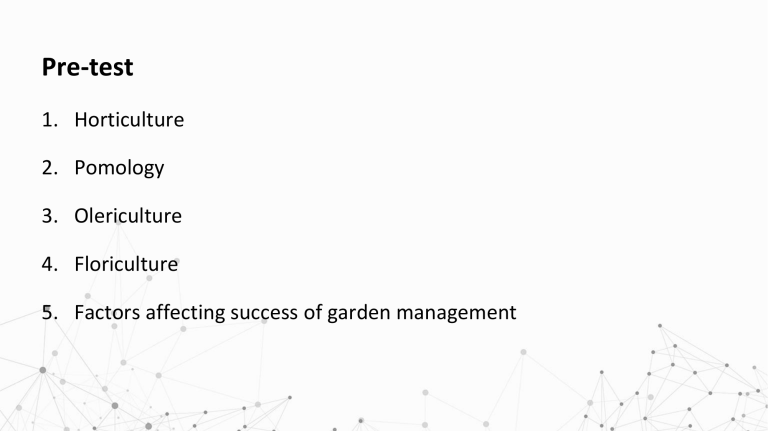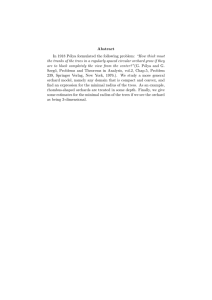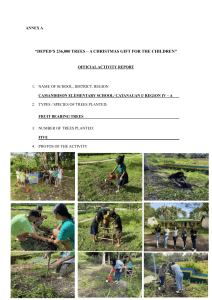
Pre-test 1. Horticulture 2. Pomology 3. Olericulture 4. Floriculture 5. Factors affecting success of garden management 6. Orchard is an area where different fruit crops are planted in an __________ manner 7-12. List down 6 lay out designs in Orchard Management. Objectives 1. To gain knowledge on good agricultural practices in Orchard Management; and 2. To explore and experience Orchard Management activities. Horticulture from the Latin words hortus, “garden,” and colere, “to cultivate” branch of plant agriculture that deals with garden crops garden management or intensive commercial production domestic gardening and field agriculture Horticulture Purposes For food: Pomology Pomology – deals with fruits and nuts Olericulture – deals with herbaceous crops/vegetables For ornament: Floriculture - deals with production of flowers and ornamental plants Landscape horticulture – includes plants for the landscape Factors Affecting Success of Garden Management Climate Terrain Regional variations Pomology (Fruit Orchard Management) Orchard – an area where different fruit crops are planted in an orderly manner; managed for production of successive yield for economic return Orchard Management the organization of operations from land selection to marketing of produce; this requires careful and proper planning Why manage your orchard? Long term investment Maximize economic returns Optimum resource utilization Increase productivity Key knowledge in orchard management Soil management Water management Nutrition management Pruning and training (plant management Weed management Plant protection (pest and diseases; human activities) Harvesting Post-harvesting Value-adding and marketing Soil Management Creates favorable conditions for moisture supply and proper drainage Maintains high fertility level Reduce soil erosion Reduce cost of cultivation Suppress weed population Intercropping, cover cropping, mulching, crop rotation, high density planting, nutrient management Water Management Influences photosynthesis, respiration, absorption, translocation and utilization of minerals Soil needs water in order to: Remove stress condition Release nutrients in soil for plant absorption Leach or wash out harmful salts from the soil Water Management Irrigation I. Surface irrigation Flooding, Basin type, Furrow type, Ring type II. Sub-surface irrigation Trench method, Underground pipelines III. Overhead or Aerial irrigation Sprinkler, Revolving nozzles IV. Drip or trickle irrigation Nutrient Management Increase soil fertility Increase availability of nutrients for plant consumption Reduce nutrient loss through leaching, runoff, volatilization and maintaining fixation of nutrients to the soil (manuring) Weed Management Reduce crop yield Hosts for pests and diseases Competes with desired crop Partially or completely parasitic to host tree Layout Design 6 Layout designs 1. Square method 2. Rectangular method 3. Triangular method 4. Quincunx method 5. Hexagonal method 6. Contour method Square Method Plot is divided into squares and trees are planted at 4 corners of square Advantages • Irrigation channels and paths can be made straight • Easy cultivation, spraying, harvesting • Better supervision Disadvantages • Limited trees in a given area • Certain amount of space wasted in the middle of 4 trees Square and Rectangular Method Quincunx/Diagonal Method Hexagonal/Triangular Method Contour/Terrace System Calculate the number of Orange tree in a square system of planting in 1 hectare area, if the row to row and plant to plant spacing is 5x5 m2. Calculate the number of Mango tree in a rectangular system of planting in 2 hectare area, if the row spacing is 10m and plant spacing is 8m. Calculate the number of Orange and Papaya tree in a quincunx system of planting in 1 hectare area, if the row to row and plant to plant spacing is 6x6 m2. Rectangular Method Plot is divided into rectangles and trees are planted at 4 corners in straight rows running at right angles Advantages • Irrigation channels and paths can be made in length with enough air passage • Possibility of intercropping Disadvantages • Limited trees in a given area • Certain amount of space wasted in the middle of 4 trees Quincunx Method Like square method, but a 5th tree is planted in the middle of each square Advantages • Additional income from filler crop • Doubled number of trees planted initially • Full use of land is possible Disadvantages • Skills required to layout the orchard • Trees in between may interfere with the growth of main crop • Spacing of main crop is reduced if filler crop continues to Triangular Method Trees planted like square method, but plants in 2, 4, 6 (alternate rows) are planted in between 1, 3, 5 and other alternate rows Advantages • Additional income from filler crop • Full use of land is possible Disadvantages • Skills required to layout the orchard • Trees in between may interfere with the growth of main crop • Spacing of main crop is reduced if filler crop continues to grow Hexagonal Method Trees planted at the corners of equilateral triangle; 6 trees (hexagon) with 1 at the center Advantages • Ideal for fertile soil and source of water • More trees can be planted Disadvantages • Same distance can be maintained • Difficult intercultural operations • More income • Skill is required Contour Method Follows the slope of the hills Advantages • Can be utilized in hilly areas • Helps control soil erosion • Helps conserve water • Easy path movements on hills for various tasks Disadvantages • Difficult in laying out contours/time consuming • Requires special skills and instruments • Not equal row-to-row distance




